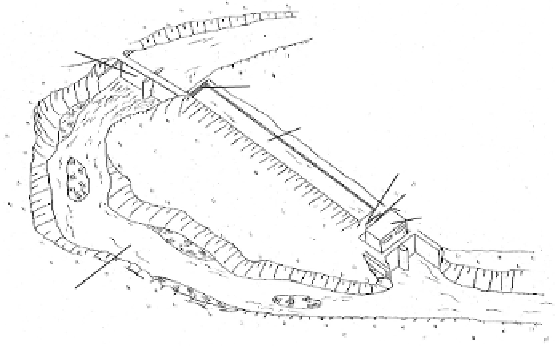Environmental Engineering Reference
In-Depth Information
Low-head plants.
Low-head plants harness the flow of a river, in most cases,
without any storage; they are typical run-of-river power stations. They are charac-
terised by a generally large flow and relatively low heads up to approximately
20 m. For example most of the run-of-river power stations in Germany are low-
head plants /8-6/.
Depending on the plant layout, diversion-type and run-of-river power stations
can be differentiated.
Diversion-type plants.
In the case of diversion-type power plants, the actual pow-
erhouse is outside the riverbed, somewhere along the course of a canal, into which
the water is diverted. This water is taken from the river at a dam, is then diverted
through the headrace or a pipeline to the power station, and transferred back to the
riverbed at the end of the tailrace (Fig. 8.4). The so-called instream flow remains
in the original riverbed. It is set according to ecological and economic criteria.
Additionally, side channel types and meander cutoff types can be distinguished
in diversion-type power stations. For the former, an artificial waterway with a
very low gradient concentrates the drop of longer river stretches together in one
place, where the power station is built (so-called canal power stations; Fig. 8.4).
Meander cutoff type run-of-river power stations have less damaging effects on the
landscape than side channel-type power stations.
Dam
Trash rack
He a d r a ce
Screen
Intake
Power house
Diverted river reach
Fig. 8.4
Example of a typical diversion-type power station
Run-of-river plants.
The term "run-of-river" power station is also used for power
stations that are built into the actual riverbed. Depending on the setup of the dam
and the turbine house the different designs described above can be used. Often,
run-of-river power stations have additional tasks in the context of flood manage-
ment, navigation (i.e. shiplock operation), and groundwater stabilisation. To give
one example, Fig. 8.5 shows a possible design typical for a stream that has not
been converted into a navigable waterway.

Search WWH ::

Custom Search